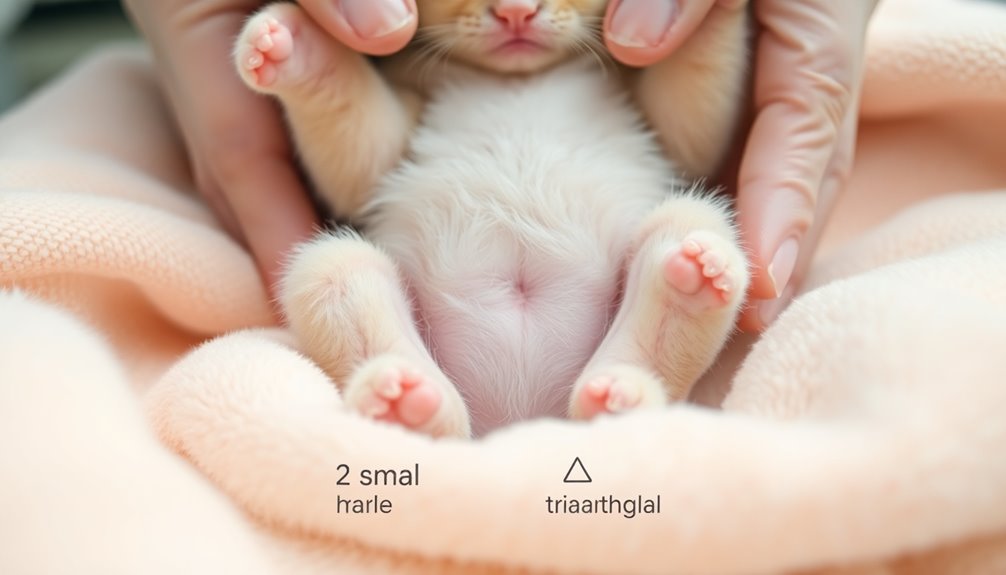To tell a kitten's sex, gently lift its tail and look at the genital area. Male kittens will have a round opening about half an inch from the anus, while females have a vertical slit that's closer to the anus. You can also note that the distance between the openings is shorter in females and longer in males. If your kitten is between 6 to 10 weeks old, check for visible testicles, which indicate it's male. Understanding these distinctions will help you accurately identify their sex, and there's more to explore about kitten care and development.
Key Takeaways
- Male kittens have a round genital opening, while females display a vertical slit, located closer to the anus.
- The anogenital distance is shorter in female kittens, resembling a straight line, compared to the greater distance in males.
- Testicles of male kittens become visible between 6 to 10 weeks, aiding in gender determination.
- Gently lift the tail for a clear view of the genital area and use visual comparisons for accurate identification.
- Consult a veterinarian for confirmation and health advice related to sex determination and care.
Anatomy of Kittens

Understanding the anatomy of kittens is essential when you need to determine their sex. The key difference lies in the kitten gender's genital opening.
Male kittens have a round genital opening that's about 1/2 inch from the anus, while female kittens show a vertical slit that's positioned closely to the anus. This distance is vital for distinguishing their sex.
As male kittens grow, you'll notice testicles appearing between 6 to 10 weeks, providing another indicator. Female kittens, on the other hand, exhibit a shorter anogenital distance, with their genital opening resembling a straight line or teardrop shape.
Lifting the tail allows for a clear view of the genital area, making it easier to identify the kitten gender accurately.
Visual Identification Techniques

To accurately identify the sex of a kitten, visual techniques are key. Start by gently lifting the kitten's tail to examine the area.
You'll first see the anus, followed by the genital opening, which differs between male and female kittens. In males, this opening appears circular and is about 1/2 inch from the anus. In contrast, female kittens have a vertical slit closer to the anus.
You'll also notice that male kittens generally have more fur and tissue between these two openings, while females have less. Observing multiple kittens can sharpen your ability to distinguish between the sexes.
Additionally, color patterns can offer hints: calico and tortoiseshell kittens are mostly female, while orange kittens are often male.
Age and Developmental Milestones

As you monitor your kitten's growth, keep an eye on their age for key milestones in sexual differentiation.
By 4-6 weeks, you can start to identify their sex, and by 8 weeks, the differences become clearer.
Understanding this timeline will help you recognize when your kitten reaches full sexual maturity around 5-6 months.
Developmental Timeline Overview
Between 4 to 6 weeks of age, kittens start to show signs of sexual differentiation, making this period essential for determining their sex. By 6 to 8 weeks, male kittens typically have visible testicles, aiding in sex determination.
Here's a quick overview of the developmental milestones:
| Age (Weeks) | Male Kittens | Female Kittens |
|---|---|---|
| 4 – 6 | Early differentiation | Early differentiation |
| 6 – 8 | Testicles visible | No visible changes |
| 8+ | Round genitalia | Vertical slit |
Age for Identification
Kittens start to show their sexual characteristics around 4 to 6 weeks of age, making this an ideal time for you to identify their sex.
At this stage, you can begin to observe the differences between male and female kittens. By 6 to 8 weeks old, male kittens may develop visible testicles, making it easier to determine their sex.
As they reach 8 weeks, the anatomical differences become even clearer, allowing for a more accurate identification.
Pay attention to the female kittens' genitals, which will appear more of a slit compared to the male kittens.
Monitoring their growth patterns and physical traits during these key weeks will help you confirm their sex as they develop.
Milestones of Sexual Maturity
Understanding the milestones of sexual maturity in your kitten is essential for ensuring their health and well-being. Here's what to watch for:
- 4-6 weeks: Kittens start showing sexual differentiation; observe the tail and body structure.
- 6-10 weeks: Male kittens develop visible testicles in the scrotum area, aiding identification.
- 5-6 months: Full sexual maturity is reached, leading to noticeable behavioral changes.
- 8 months: Monitor growth patterns and behaviors to address any health issues, like urinary tract problems in males or pyometra in females.
Veterinary Recommendations

When determining the sex of a kitten, consulting a veterinarian is your best bet for accurate results. They can provide professional guidance and confirm findings through a thorough examination.
Regular veterinary check-ups are essential for monitoring your kitten's health and development, regardless of gender. These visits also help identify any potential health issues linked to the kitten's sex, such as urinary tract problems in males or reproductive concerns in females.
If you're unsure about sexing your kitten, a veterinarian can advise you on appropriate spaying or neutering timelines, helping to prevent unwanted behaviors and health issues.
Additionally, veterinary professionals often offer educational resources and visual aids to enhance your understanding of kitten anatomy and the differences between male and female kittens.
Identifying Female Kittens

Identifying female kittens can be straightforward with a little observation. To help you determine the sex, follow these tips:
- Look for a vertical slit: Female kittens have a genital opening shaped like a vertical slit or teardrop.
- Check the distance: The distance between the anus and the vaginal opening is shorter in females, making identification easier.
- Observe the fur: Female kittens usually have less excess fur and tissue around their genital area than males.
- Consider coat color: Tricolor (calico) kittens are mainly female due to their genetic makeup.
Gently lift the tail and carefully observe the shape and positioning of the openings for accurate identification.
With practice, you'll become more confident in distinguishing female kittens.
Identifying Male Kittens

After learning how to spot female kittens, you can turn your attention to male kittens, which have their own distinct characteristics.
To identify male kittens, look for a circular genital opening located below the anus, which is about half an inch away. As they grow, usually between 6 to 10 weeks, you'll notice visible testicles developing.
The area at the base of the tail may have extra fur and tissue, setting them apart from females, whose genitalia appear as a vertical slit. Additionally, male kittens tend to be larger, with bigger body and head sizes.
If you're unsure, gently palpate the scrotum; you'll feel oval shapes indicating the presence of testicles, confirming their male sex.
Additional Resources for Pet Owners

When it comes to identifying the sex of your kitten, there are plenty of resources at your fingertips.
You can find visual identification tools online, consult with your vet for expert support, and explore educational articles for thorough guidance.
These options will help you feel confident in caring for your new furry friend.
Visual Identification Tools
Visual identification tools are invaluable for any pet owner trying to determine the sex of a kitten. You can make the process easier with these resources:
- Online Guides: Websites like the Kitten Lady offer visual comparisons of male and female genitalia.
- Downloadable Fact Sheets: Access quick reference sheets detailing genital differences for on-the-spot help.
- Veterinary Materials: Clinics often provide educational resources on physical and behavioral traits of each sex.
- Lighting Techniques: Use a flashlight to illuminate the area around the kitten's genitalia, enhancing visibility for easier identification.
Additionally, understanding physical traits can aid in distinguishing between male and female kittens.
These tools empower you to make informed decisions about your kitten's sex, ensuring you're well-prepared for their care.
Veterinary Support Options
While you can use various tools to identify a kitten's sex, consulting a veterinarian is essential for accurate determination. A vet can confirm findings through a physical examination and provide professional guidance.
Regular veterinary check-ups not only help monitor your kitten's development but also identify any potential gender-specific health issues early on. Many veterinary practices offer educational resources, like brochures and fact sheets, which can assist you in understanding how to identify the sex of kittens.
Additionally, veterinarians can advise on caring for male and female kittens, including spaying and neutering options that prevent certain health risks. Accessing veterinary support enhances your knowledge about kitten behavior and development, ensuring better overall care for your pets. Moreover, understanding alimony types can be crucial if you are considering your financial responsibilities as a pet owner during a divorce.
Online Educational Resources
Accessing online educational resources can greatly enhance your ability to identify a kitten's sex. Here are some valuable resources to evaluate:
- Kitten Lady: This website features visual galleries comparing male and female genital structures for clearer identification.
- Infographics: Many sites provide infographics summarizing the key characteristics, like anogenital distance and shape, simplifying the sex determination process.
- Webinars: Veterinary clinics and animal welfare organizations often host webinars that focus on kitten care, including sex determination techniques.
- Online Forums: Join community groups to share experiences and seek advice from other pet owners on identifying kitten gender effectively.
Utilizing these resources can help you confidently distinguish between male and female kittens.
Frequently Asked Questions
How to Tell if a Kitten Is a Boy or a Girl?
To determine if a kitten's a boy or a girl, you've gotta take a close look at their private parts.
Gently lift their tail and observe the genital area. If you see a circular opening, it's a male; if it's a vertical slit, it's a female.
You might also notice that male kittens have a greater distance between the anus and genital opening.
Check around 8 weeks for clearer signs!
How Old Until You Can Tell a Kitten's Gender?
You can typically tell a kitten's gender around 8 weeks of age.
Before that, subtle differences might start to show around 4 to 6 weeks, but they're not very distinct.
By 6 to 10 weeks, male kittens often begin to exhibit visible testicles, making identification easier.
As they grow, the anogenital distance becomes more pronounced, and by 5 to 6 months, the physical distinctions are much clearer.
What Does a Female Kitten's Private Look Like?
When you take a closer look at a female kitten's private area, you might notice something intriguing.
It appears as a vertical slit or teardrop shape, located just below the anus. You'll see that the distance between the two is shorter than in males, often less than half an inch.
If you observe carefully, it might even resemble an upside-down exclamation point. This unique anatomy becomes clearer around eight weeks of age.
How Do I Know if My Kitten Has Sex?
To know your kitten's sex, you'll need to take a closer look. Gently lift the tail and observe the genital area.
Male kittens have a round opening farther from the anus, while females have a vertical slit closer to it.
If you're unsure, don't hesitate to ask a vet for help. They'll provide the best guidance, ensuring you accurately identify your kitten's sex and understand any other needs they might have.
Conclusion
In summary, knowing how to tell the sex of a kitten can be as essential as picking the right playlist for a road trip. By observing their anatomy, using visual techniques, and considering their age, you can confidently identify whether you've got a little prince or princess on your hands. Don't hesitate to consult your vet for further guidance. Now that you're equipped with this knowledge, you're ready to give your new furry friend the best start in life!










